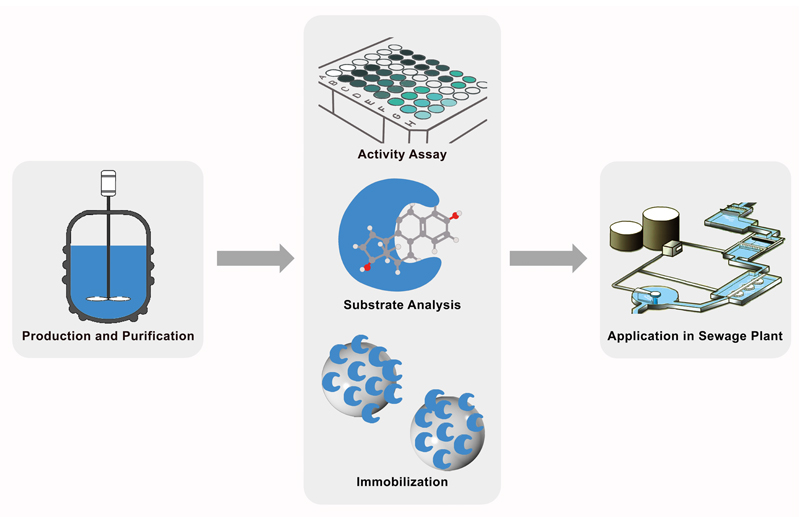Team:Bielefeld-Germany/Judging
From 2012.igem.org
(→How our BioBricks work) |
(→We have also characterized the following parts) |
||
| Line 77: | Line 77: | ||
# <partinfo>BBa_K863012</partinfo> - '''tthl laccase (from ''T. thermophilus'') with constitutive promoter J23100, RBS and His-tag''': This part is used for the constitutive expression of tthl for further purification followed by characterization of enzyme activity and substrate specificity. | # <partinfo>BBa_K863012</partinfo> - '''tthl laccase (from ''T. thermophilus'') with constitutive promoter J23100, RBS and His-tag''': This part is used for the constitutive expression of tthl for further purification followed by characterization of enzyme activity and substrate specificity. | ||
# <partinfo>BBa_K863022</partinfo> - '''bhal laccase (''from Bacillus halodurans'') with constitutive promoter J23100, RBS and His-tag''': This part is used for the constitutive expression of bhal for further purification followed by characterization of enzyme activity and substrate specificity. | # <partinfo>BBa_K863022</partinfo> - '''bhal laccase (''from Bacillus halodurans'') with constitutive promoter J23100, RBS and His-tag''': This part is used for the constitutive expression of bhal for further purification followed by characterization of enzyme activity and substrate specificity. | ||
| - | + | # <partinfo>BBa_K863207</partinfo> - '''shuttle vector pECPP11JS for site-directed recombination of TVEL5 laccase in yeast: With this part the production and secretion of TVEL5 is possible. | |
<html> | <html> | ||
| Line 91: | Line 91: | ||
__NOTOC__ | __NOTOC__ | ||
<div style="text-align:justify;"> | <div style="text-align:justify;"> | ||
| + | |||
== Collaboration with the iGEM Team from [https://2012.igem.org/Team:University_College_London University College London]== | == Collaboration with the iGEM Team from [https://2012.igem.org/Team:University_College_London University College London]== | ||
We started collaboration with the iGEM Team [https://2012.igem.org/Team:University_College_London University College London]. They also work with a laccase, the laccase from ''E. coli'' W3110. So we had good requirements to characterize each other’s laccases with the different methods we used to characterize the proteins. Therefore we sent our part <partinfo>BBa_K863005</partinfo> and got the part <partinfo>BBa_K729006</partinfo>. In our experiments we showed that their laccase is expressed and active using our [https://2012.igem.org/Team:Bielefeld-Germany/Protocols/Analytics#Activity_measurements activity test] with ABTS. <br> For more detailed information about the methods we used for characterization and the results have a look on the [https://2012.igem.org/Team:Bielefeld-Germany/Results/london Result Page] or the entry in [http://partsregistry.org/Part:BBa_K729006:Experience Parts Registry]. | We started collaboration with the iGEM Team [https://2012.igem.org/Team:University_College_London University College London]. They also work with a laccase, the laccase from ''E. coli'' W3110. So we had good requirements to characterize each other’s laccases with the different methods we used to characterize the proteins. Therefore we sent our part <partinfo>BBa_K863005</partinfo> and got the part <partinfo>BBa_K729006</partinfo>. In our experiments we showed that their laccase is expressed and active using our [https://2012.igem.org/Team:Bielefeld-Germany/Protocols/Analytics#Activity_measurements activity test] with ABTS. <br> For more detailed information about the methods we used for characterization and the results have a look on the [https://2012.igem.org/Team:Bielefeld-Germany/Results/london Result Page] or the entry in [http://partsregistry.org/Part:BBa_K729006:Experience Parts Registry]. | ||
Revision as of 23:53, 26 October 2012
Our BioBricks
<groupparts>iGEM012 Bielefeld-Germany</groupparts>
Datapage
How our BioBricks work

Data for our favorite new parts
- <partinfo>K863000</partinfo> - bpul (laccase from Bacillus pumilus) with T7 promoter, RBS and His-tag: This part is used to overexpress the laccase bpul for further purification followed by characterization of enzyme activity and substrate specificity.
- <partinfo>K863005</partinfo> - ecol (laccase from E. coli) with T7 promoter, RBS and His-tag: This enzyme is overexpressed after induction and can be purified by His-tag. Subsequently the laccase can be characterized regarding to enzyme activity and substrate specificity.
- <partinfo>K863204</partinfo> - shuttle vector pECPP11JS for site-directed recombination of genes of interest in yeast: With this part the production and secretion of a protein of interest like laccase is possible.
We have also characterized the following parts
- <partinfo>BBa_K863012</partinfo> - tthl laccase (from T. thermophilus) with constitutive promoter J23100, RBS and His-tag: This part is used for the constitutive expression of tthl for further purification followed by characterization of enzyme activity and substrate specificity.
- <partinfo>BBa_K863022</partinfo> - bhal laccase (from Bacillus halodurans) with constitutive promoter J23100, RBS and His-tag: This part is used for the constitutive expression of bhal for further purification followed by characterization of enzyme activity and substrate specificity.
- <partinfo>BBa_K863207</partinfo> - shuttle vector pECPP11JS for site-directed recombination of TVEL5 laccase in yeast: With this part the production and secretion of TVEL5 is possible.
Collaborations
Collaboration with the iGEM Team from University College London
We started collaboration with the iGEM Team University College London. They also work with a laccase, the laccase from E. coli W3110. So we had good requirements to characterize each other’s laccases with the different methods we used to characterize the proteins. Therefore we sent our part <partinfo>BBa_K863005</partinfo> and got the part <partinfo>BBa_K729006</partinfo>. In our experiments we showed that their laccase is expressed and active using our activity test with ABTS.
For more detailed information about the methods we used for characterization and the results have a look on the Result Page or the entry in [http://partsregistry.org/Part:BBa_K729006:Experience Parts Registry].
Collaboration with the iGEM team from the Southern University of Denmark
We invited the iGEM Team from the Southern University of Denmark to Bielefeld to share and exchange knowledge and of course to meet another iGEM team. Furthermore they supported us on our event Street Science. You can find all information about our meeting here.
Collaboration with the iGEM team from the LMU Munich
We sent our plasmids with ECOL <partinfo>BBa_K863005</partinfo> and BHAL (<partinfo>BBa_K863020</partinfo> to the LMU Munich iGEM Team. They wanted to express the laccases on their Bacillus subtilis sporobeads to immobilize the laccases.
Collaboration with the UBC iGEM team
The UBC iGEM team prepared an Intellectual Property Survey, which was answered by our whole team.
Collaboration with the TU Munich
| 55px | | | | | | | | | | |
 "
"







